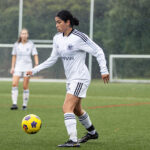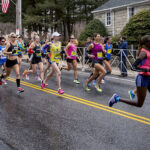Five running exercises you can do at home

Unlike a lot of athletes, runners haven’t had to take time off during COVID-19. In fact, a lot of athletes have been running until they can safely return to their sports of choice. Whether you’re a new or seasoned runner, strength training is an important way to reduce your risk of injury.
These five running exercises, done two or three times a week, will help build strength and stability in the muscles you use on your runs.
3-way bridge
Areas worked: Gluteals, hamstrings
Equipment: A floor is all you need to do this running exercise. An exercise mat can provide extra padding. Doing this exercise with a step or foam roller under your feet will increase the difficulty.
Recommended repetitions: This exercise includes three styles of bridge, which are demonstrated in the video. The goal is to be able to do each style, one after the other. Start out low by doing three to five repetitions of each style. For example, bridge five times, single-leg bridge five times on each side, marching bridge five times on each side.
As you get stronger and the exercise gets easier, increase the repetitions to 8, then 10, then 12, and maybe 15. Start with one set and increase to two sets.
Tips:
- You should feel this exercise in the back of your legs (hamstrings and gluteals).
- If you feel the muscles in the front of your legs (quadriceps), press your heels into the ground and adjust the placement of your feet.
- If you feel discomfort in your low back, try toning up your abdominal muscles.
- If you experience any cramping in your hamstrings, try squeezing your gluteals more, do fewer reps, or do some gentle stretching in between each style of bridge.
Hip/ankle floss
Areas worked: Hip flexors, hamstrings, ankles, feet
Equipment: Use a pillow or exercise mat for padding under your knees if you wish. You can use two yoga blocks or a wall for balance, but they are not necessary.
Recommended repetitions: This is a dynamic exercise. It keeps you moving with some short holds at the end positions. Count to five as you move forward, hold for five seconds, then count to five as you move backward, and hold for five seconds. For a deeper stretch, try holding for up to 10 seconds. Repeat five to eight times on each side.
Tips:
- The hip flexor and hamstring stretch can be rather intense. Therefore, be sure to only go so far and back off if you feel pain (or can’t breathe).
- When in the forward position, be be sure your hips don’t sink.
- Be sure your forward knee doesn’t extend beyond your foot. The front heel should stay down. Squeezing your glute can help.
Psoas activation
Areas worked: Core muscles (specifically the psoas), hip flexors
Equipment: Resistance band tied in a loop
Recommended repetitions: Two sets of five to eight repetitions
Tips:
- Flatten your back against the ground by tightening your abdominal muscles.
- Keep a little window open between your hips and knees for proper alignment.
- Flex your feet so the resistance band doesn’t become a projectile.
- Reach through your heel as you straighten the leg out. The leg shouldn’t “clunk” toward the floor.
Airplane
Areas worked: Hips, hamstrings, single-leg balance
Equipment: A mirror can be helpful to check your alignment. But otherwise all you need is you.
Recommended repetitions: Three sets of eight repetitions on each leg.
Tips:
- Think about reaching out through your arm and the heel of your back leg with your toe pointed toward the floor. This will help keep your hips even and make the exercise feel light in your hips.
- Use your glute muscle to keep the “flying” leg lifted.
- Only lower yourself as far as you can and still lift yourself back up. With practice this gets much easier.
Runners climb
Areas worked: Hips, ankles, quadriceps, hamstrings, gluteals, single-leg balance
Equipment: The lowest step on the stairs at home, a stable stool, or exercise step. A mirror can help you check alignment.
Recommended repetitions: Start with three sets of 10 on each side with a little break in between sets. Progress to two sets of 15 repetitions, and finally 30 repetitions straight through.
Tips:
- Make sure the step isn’t too high. At the starting position, your foot on the step and the one on the ground should be lined up next to each other (watch that the ground leg doesn’t move backwards).
- Send your hips back to help get your heel closer to the step.
- Use your hips to push up to the standing position.
- Land with a soft, bent knee each time.
- A mirror can be helpful to watch your knee alignment and make sure that it doesn’t dive inwards.
Related: What running mistakes lead to injury?
Learn about the Injured Runner Clinic and Sports Medicine Division.
About our blogger: Sara Collins, L/ATC, CPT, is an injury prevention specialist at The Micheli Center for Sports Injury Prevention and former member and injury prevention specialist for Team in Training.
Related Posts :
-

Jackie’s dreams of playing professional soccer back on track after ACL surgery
From her dorm in Newcastle, England, Jackie Zapata can hear fans roaring in the soccer stadium a few blocks away. ...
-

The surprising energy demands of marathon training
Training for a marathon? Are you eating enough to help your body recover from one long training run and gear ...
-

A heavy-medaled gymnast and his close call with leg-length discrepancy
Ask 15-year-old Kaleb what he likes about gymnastics and with a sly smile, he’ll say, “flipping around.” That’s ...
-

Fuel to be faster: Studying the effects of low energy availability at the Boston Marathon
Like many sports medicine specialists, Kristin Whitney, MD, MA, suspected that many of the issues she treats in runners — bone ...





